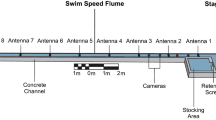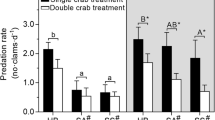Abstract
Critical swimming speed (UCrit) is a standard test to measure sustained swimming capabilities of fish species, however, much of this research is focused on pelagic fish or popular game fish. Recently, more research is emerging on the swimming capabilities of sturgeons, mainly due to their conservation status. Substrate preference has been examined in sturgeons, however, few studies have investigated whether sturgeon would select for a particular substrate (smooth or pebble) when provided a choice under high-flow conditions, as irregular shaped bottom substrates may provide an energetic advantage. Critical swimming tests were performed in a linear flume to evaluate whether substrate (smooth, pebble, pebble on the left side of the flume/smooth on the right side of the flume, and pebble on the right side of the flume/smooth on the left side of the flume) would affect UCrit of juvenile shortnose sturgeon (Acipenser brevirostrum), and if the sturgeon would select for a particular substrate at different speeds. All swimming experiments were video recorded and subsequently reviewed to determine the amount of time individual sturgeon spent in particular sections of the flume. Overall, there was no clear preference for a particular substrate and substrate configuration did not affect UCrit. These results may be attributed to small sample sizes, and the small pebble sizes used in relation to the sturgeon’s body size may not elicit an energetic advantage.



Similar content being viewed by others
References
Adams SR, Parsons GR, Hoover JJ, Killgore KJ (1997) Observations of swimming ability in shovelnose sturgeon (Scaphirhynchus platorynchus). J Freshw Ecol 12(4):631–633
Adams SR, Hoover JF, Killgore KJ (1999) Swimming endurance of juvenile pallid sturgeon, Scaphirhynchus albus. Copeia 3:802–807
Adams SR, Adms GL, Parsons GR (2003) Critical swimming speed and behaviour of juvenile shovelnose sturgeon and pallid sturgeon. Trans Am Fish Soc 132:37–41
Allen PJ, Hodge B, Werner I, Cech J Jr (2006) Effects of ontogeny, season, and temperature on the swimming performance of juvenile green sturgeon (Acipenser medirostris). Can J Fish Aquat Sci 63:1360–1369
Allen TC, Phelps QE, Davinroy RD, Lamm DM (2007) A laboratory examination of substrate, water depth and light use at two water velocity levels by individual pallid (Scaphirhynchus albus) shovelnose (Scaphirhynchus plarorynchus) sturgeon. J Appl Ichthyol 23:375–381
Brett JR (1964) The respiratory metabolism and swimming performance of young sockeye salmon. J Fish Res Board Can 21:1183–1226
Carlson RL, Lauder GV (2010) Living on the bottom: kinematics of benthic station- holding in darter fishes (Percidae: Etheostomatinae). J Morphol 271(1):25–35
Carlson RL, Lauder GV (2011) Escaping the flow: boundary layer use by the darter Etheostoma tetrazonum (Percidae) during benthic station-holding. J Exp Biol 214:1181–1193
Chan MD, Dibble ED, Killgore KJ (1997) A laboratory examination of water velocity and substrate preference by age-0 gulf sturgeon. Trans Am Fish Soc 126:330–333
Cheong TS, Kavvas ML, Anderson EK (2006) Evaluation of adult white sturgeon swimming abilities and applications to fishway design. Environ Biol Fish 77:197–208
Deslauriers D, Kieffer JD (2011) The influence of flume length and group size on swimming performance in shortnose sturgeon (Acipenser brevirostrum). J Fish Biol 79:1146–1155
Deslauriers D, Kieffer JD (2012) The effects of temperature on swimming performance of juvenile shortnose sturgeon (Acipener brevirostrum). J Appl Ichthyol 28:176–181
Falahatkar B, Shakoorian M (2011) Indications for substrate preferences in juvenile hatchery-reared great sturgeon, Huso huso. J Appl Ichthyol 27:581–583
Farrell AP (2008) Comparisons of swimming performance in rainbow trout using constant acceleration and critical swimming speed tests. J Fish Biol 72:693–710
Geist DR, Brown RS, Cullinan V, Brink SR, Lepla K, Bates P, Chandler JA (2005) Movement, swimming speed and oxygen consumption of juvenile white sturgeon in response to changing flow, water temperature, and light level in the Snake River, Idaho. Trans Am Fish Soc 134(4):803–816
Gilbert MJH, Barbarich JM, Casselman M, Kasurak AV, Higgs DM, Tierney KB (2016) The role of substrate holding in achieving critical swimming speeds: a case study using the invasive round goby (Neogobius melanostomus). Environ Biol Fish 99:793–799
Hammer C (1995) Fatigue and exercise tests with fish. Comp Biochem Phys A 112:1–20
He X, Lu S, Liao M, Zhu X, Zhang M, Li S, You X, Chen J (2013) Effects of age and size on critical swimming speed of juvenile Chinese sturgeon at seasonal temperatures. J Fish Biol 82:1047–1056
Hoover JJ, Collins J, Boysen KA, Katzenmeyer AW, Killgore KJ (2011) Critical swimming speeds of adult shovelnose sturgeon in rectilinear and boundary layer flow. J Appl Ichthyol 27:226–230
Kieffer JD, Arsenault LM, Litvak MK (2009) Behaviour and performance of juvenile shortnose sturgeon Acipenser brevirostrum at different water velocities. J Fish Biol 74:674–682
Kieffer JD, (2010) Exercise in fish: 50+ years and going strong. Comp Biochem and Physiol A 156:163–168
Lee CG, Farrell AP, Lotto A, Hinch SG, Healey MC (2003) Excess post-exercise oxygen consumption in adult sockeye (Oncorhynchus nerka) and coho (O. kisutch) salmon following critical speed swimming. J Exp Biol 206:3253–3260
May LE, Kieffer JD (2016) The effect of substratum type on aspects of swimming performance and behaviour in shortnose sturgeon Acipenser brevirostrum. doi:10.1111/jfb.13159
Peake S (1999) Substrate preference of juvenile hatchery-reared lake sturgeon, Acipenser fulvescens. Environ Biol Fish 56:367–374
Peake S (2004) An evaluation of the use of critical swimming speed for determination of culvert water velocity criteria for smallmouth bass. Trans Am Fish Soc 133:1472–1479
Peake S, Beamish FWH, McKinley RS, Katopodis C, Scruton DA (1995) Swimming performance of lake sturgeon (Acipenser fulvescens). Canadian technical reports of fisheries and aquatic sciences 2063. Available at http://publications.gc.ca/collections/collection_2012/mpo-dfo/Fs97-6-2063-eng.pdf
Peake S, Barth C, McKinley RS (1997) Effect of recovery parameters on critical swimming speed of juvenile rainbow trout (Oncorhynchus mykiss). Can J Zool 75:1724–1727
Plaut I (2001) Critical swimming speed: its ecological relevance. Comp Biochem Phys A 131:41–50
Qu Y, Duan M, Yan J, Feng G, Liu J, Zhang P (2013) Effects of lateral morphology on swimming performance in two sturgeon species. J Appl Ichthyol 29:310–315
Verhille CE, Poletto JB, Cocherell DE, DeCourten B, Baird S, Cech JJ Jr, Fangue NA (2014) Larval green and white sturgeon swimming performance in relation to water-diversion flows. Conserv Physiol 2(1):1–14
Webb W (1986) Kinematics of lake sturgeon, Acipenser fulvescens, at cruising speeds. Can J Zool 64:2137–2141
Wishingrad V, Ferrari MCO, Chivers DP (2014) Behavioural and morphological defences in a fish with a complex antipredator phenotype. Anim Behav 95:137–143
Wishingrad V, Musgrove AB, Chivers DP, Ferrari MCO (2015) Risks in a changing world: environmental cues drive anti-predator behaviour in lake sturgeon (Acipenser fulvescens) in the absence of predators. Behaviour 152:635–652
Zar JH (1999) Biostatistical analysis, 4th edn. Upper Saddle River, NJ: Prentice Hall
Acknowledgments
The authors thank Dr. H. Hunt and M.J. Maltais for use and technical support of the experimental flume and G. Allaby for assistance with video analysis. This research was funded by a Natural Science and Engineering Council Grant of Canada (NSERC) discovery grant to J.D.K. Support was also provided by the MADSAM Sturgeon Eco-physiology lab and the New Brunswick Innovation Fund. All procedures followed the guidelines of animal use set out by the Canadian Council of Animal Care and were approved by the institution’s Animal Care Committee.
Author information
Authors and Affiliations
Corresponding author
Rights and permissions
About this article
Cite this article
Downie, A.T., Kieffer, J.D. A split decision: the impact of substrate type on the swimming behaviour, substrate preference and UCrit of juvenile shortnose sturgeon (Acipenser brevirostrum). Environ Biol Fish 100, 17–25 (2017). https://doi.org/10.1007/s10641-016-0548-z
Received:
Accepted:
Published:
Issue Date:
DOI: https://doi.org/10.1007/s10641-016-0548-z




